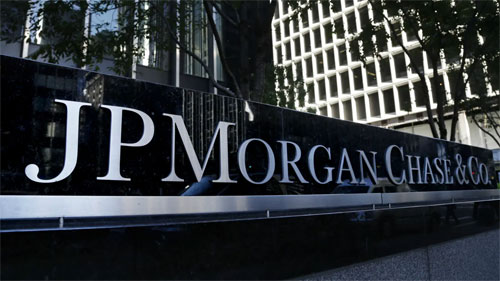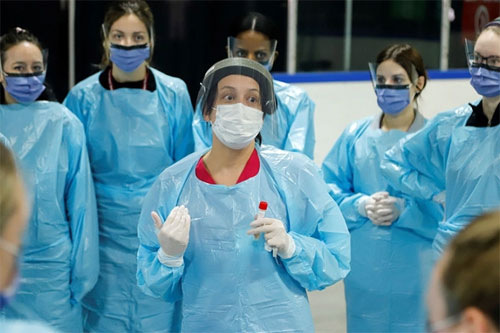Lockdowns, coronavirus, and banks: following the money (2)
Read the first part of the article
Was Covid-19 a cover for an anticipated or planned financial crisis?
A major sign of financial distress in the US economy kicked in in mid-September of 2019 when there was a breakdown in the normal operation of the Repo Market. This repurchase market in the United States is important in maintaining liquidity in the financial system.

Those directing entities like large banks, Wall Street traders and hedge funds frequently seek large amounts of cash on a short-term basis. They obtain this cash from, for instance, money market funds by putting up securities, often Treasury Bills, as collateral. Most often the financial instruments go back, say the following night, to their original owners with interest payments attached for the use of the cash.
In mid-September the trust broke down between participants in the Repo Market. The Federal Reserve Bank of New York then entered the picture making trillions of dollars available to keep the system for short-term moving of assets going. This intervention repeated the operation that came in response to the first signs of trouble as Wall Street moved towards the stock market crash of 2008.
One of the major problems on the eve of the bailout of 2008-09, like the problem in the autumn of 2019, had to do with the overwhelming of the real economy by massive speculative activity. The problem then, like a big part of the problem now, involves the disproportionate size of the derivative bets. The making of these bets have become a dangerous addiction that continues to this day to menace the viability of the financial system headquartered on Wall Street.
By March of 2020 it was reported that the Federal Reserve Bank of New York had turned on its money spigot to create $9 trillion in new money with the goal of keeping the failing Repo Market operational. The precise destinations of that money together with the terms of its disbursement, however, remain a secret. As Pam Martens and Russ Martens write, “Since the Fed turned on its latest money spigot to Wall Street [in September of 2019], it has refused to provide the public with the dollar amounts going to any specific banks. This has denied the public the ability to know which financial institutions are in trouble. The Fed, exactly as it did in 2008, has drawn a dark curtain around troubled banks and the public’s right to know, while aiding and abetting a financial coverup of just how bad things are on Wall Street.”
Looking back at the prior bailout from their temporal vantage point in January of 2020, the authors noted “During the 2007 to 2010 financial collapse on Wall Street – the worst financial crisis since the Great Depression, the Fed funnelled a total of $29 trillion in cumulative loans to Wall Street banks, their trading houses and their foreign derivative counterparties.”
The authors compared the rate of the transfer of funds from the New York Federal Reserve Bank to the Wall Street banking establishment in the 2008 crash and in the early stages of the 2020 financial debacle. The authors observed, “at this rate, [the Fed] is going to top the rate of money it threw at the 2008 crisis in no time at all.”
The view that all was well with the economy until the impact of the health crisis began to be felt in early 2020 leads away from the fact that money markets began to falter dangerously in the autumn of 2019. The problems with the Repo Market were part of a litany of indicators pointing to turbulence ahead in troubled economic waters.
For instance, the resignation in 2019 of about 1,500 prominent corporate CEOs can be seen as a suggestion that news was circulating prior to 2020 about the imminence of serious financial problems ahead. Insiders’ awareness of menacing developments threatening the workings of the global economy were probably a factor in the decision of a large number of senior executives to exit the upper echelons of the business world.
Not only did a record number of CEOs resign, but many of them sold off the bulk of their shares in the companies they were leaving. Pam Marten and Russ Marten who follow Wall Street’s machinations on a daily basis have advanced the case that the Federal Reserve is engaged in fraud by trying to make it seem that “the banking industry came into 2020 in a healthy condition,” that it is only because of “the Covid-19 pandemic” that the financial system is “unravelling.”
The authors argue that this misrepresentation was deployed because the deceivers are apparently “desperate” to prevent Congress from conducting an investigation for the second time in twelve years on why the Fed, “had to engage in trillions of dollars of Wall Street bailouts.” In spite of the Fed’s fear of facing a Congressional investigation after the November 2020 vote, such a timely investigation of the US financial sector would well serve the public interest.
The authors present a number of signs demonstrating that “the Fed knew, or should have known…. that there was a big banking crisis brewing in August of last year. [2019]” The signs of the financial crisis in the making included negative yields on government bonds around the world as well as big drops in the Dow Jones average. The plunge in the price of stocks was led by US banks, but especially Citigroup and JP Morgan Chase.
Another significant indicator that something was deeply wrong in financial markets was a telling inversion in the value of Treasury notes with the two-year rate yielding more than the ten-year rate.
Yet another sign of serious trouble ahead involved repeated contractions in the size of the German economy. Moreover, in September of 2019 news broke that officials of JP Morgan Chase faced criminal charges for RICO-style racketeering. This scandal added to the evidence of converging problems plaguing core economic institutions as more disruptive mayhem gathered on the horizons.

Accordingly, there is ample cause to ask if there are major underlying reasons for the financial crash of 2020 other than the misnamed pandemic and the lockdowns done in its name of “flattening” its spikes of infection. At the same time, there is ample cause to recognize that the lockdowns have been a very significant factor in the depth of the economic debacle that is making 2020 a year like no other.
Some go further. They argue that the financial crash of 2020 was not only anticipated but planned and pushed forward with clear understanding of its instrumental role in the Great Reset sought by self-appointed protagonists of creative destruction. The advocates of this interpretation place significant weight on the importance of the lockdowns as an effective means of obliterating in a single act a host of old economic relationships. For instance Peter Koenig examines the “farce and diabolical agenda of a universal lockdown.”
Koenig writes, “The pandemic was needed as a pretext to halt and collapse the world economy and the underlying social fabric.”
Inflating the numbers and traumatizing the public to energize the epidemic of fear
There have been many pandemics in global history whose effects on human health have been much more pervasive and devastating than the current one said to be generated by a new coronavirus. In spite, however, of its comparatively mild flu-like effects on human health, at least at this point in the summer of 2020, there has never been a contagion whose spread has generated so much global publicity and hype. As in the aftermath of 9/11, this hype extends to audacious levels of media-generated panic. As with the psyop of 9/11, the media-induced panic has been expertly finessed by practitioners skilled in leveraging the currency of fear to realize a host of radical political objectives.
According to Robert E. Wright in an essay published by the American Institute for Economic Research, “closing down the U.S. economy in response to Covid-19 was probably the worst public policy in at least one-hundred years.” As Wright sees it, the decision to lock down the economy was made in ignorant disregard of the deep and devastating impact that such an action would spur. “Economic lockdowns were the fantasies of government officials so out of touch with economic and physical reality that they thought the costs would be fairly low.”
The consequences, Wright predicts, will extend across many domains including the violence done to the rule of law. The lockdowns, he writes, “turned the Constitution into a frail and worthless fabric.” Writing in late April, Wright touched on the comparisons to be made between the economic lockdowns and slavery. He write, “Slaves definitely had it worse than Americans under lockdown do, but already Americans are beginning to protest their confinement and to subtly subvert authorities, just as chattel slaves did.”
The people held captive in confined lockdown settings have had the time and often the inclination to imbibe much of the 24/7 media coverage of the misnamed pandemic. Taken together, all this media sensationalism has come to constitute one of the most concerted psychological operations ever.
The implications have been enormous for the mental health of multitudes of people. This massive alteration of attitudes and behaviours is the outcome of media experiments performed on human subjects without their informed consent. The media’s success in bringing about herd subservience to propagandistic messaging represents a huge incentive for more of the same to come. It turns out that the subject matter of public health offers virtually limitless potential for power-seeking interests and agents to meddle with the privacies, civil liberties and human rights of those they seek to manipulate, control and exploit.
The social, economic and health impacts of the dislocations flowing from the lockdowns are proving to be especially devastating on the poorest, the most deprived and the most vulnerable members of society. This impact will continue to be marked in many ways, including in increased rates of suicide, domestic violence, mental illness, addictions, homelessness, and incarceration far larger than those caused directly by Covid-19. As rates of deprivation through poverty escalate, so too will crime rates soar.
The over-the-top alarmism of the big media cabals has been well financed by the advertising revenue of the pharmaceutical industry. With some few exceptions, major media outlets pushed the public to accept the lockdowns as well as the attending losses in jobs and business activity. In seeking to push the agenda of their sponsors, the big media cartels have been especially unmindful of their journalistic responsibilities. Their tendency has been to avoid or censor forums where even expert practitioners of public health can publicly question and discuss government dictates about vital issues of public policy.
Whether in Germany or the United States or many other countries, front line workers in this health care crisis have nevertheless gathered together with the goal of trying to correct the one-sided prejudices of discriminatory media coverage. One of the major themes in the presentations by medical practitioners is to confront the chorus of media misrepresentations on the remedial effects of hydroxychloroquine and zinc. On July 27 a group of doctors gathered on the grounds of the US Supreme Court to try to address the biases of the media and the blind spots of government.

Another aspect in the collateral damage engendered by Covid-19 alarmism is marked in the fatalities arising from the wholesale postponement of many necessary interventions including surgery. How many have died or will die because of the hold put on medical interventions to remedy cancer, heart conditions and many other potentially lethal ailments?
Did the unprecedented lockdowns come about as part of a preconceived plan to inflate the severity of an anticipated financial meltdown? What is to be made of the suspicious intervention of administrators to produce severely padded numbers of reported deaths in almost every jurisdiction? This kind of manipulation of statistics raised the possibility that we are witnessing a purposeful and systemic inflation of the severity of this health care crisis.
Questions about the number of cases arise because of the means of testing for the presence of a supposedly new coronavirus. The PCR system that is presently being widely used does not test for the virus but tests for the existence of antibodies produced in response to many health challenges including the common cold. This problem creates a good deal of uncertainty of what a positive test really means.
The problems with calculating case numbers extend to widespread reports that have described people who were not tested for Covid-19 but who nevertheless received notices from officials counting them as Covid-19 positive. Broadcaster Armstrong Williams addressed the phenomenon on his network of MSM media outlets in late July. From the mass of responses he received, Williams estimated that those not tested but counted as a positive probably extends probably to hundreds of thousands of individuals. What would drive the effort to exaggerate the size of the afflicted population?
This same pattern of inflation of case numbers was reinforced by the Tricare branch of the US Defense Department’s Military Health System. This branch sent out notices to 600,000 individuals who had not been tested. The notices nevertheless informed the recipients that they had tested positive for Covid 19.
Is the inflation of COVID-19 death rates and cases numbers an expression of the zeal to justify the massive lockdowns? Were the lockdowns in China conceived as part of a scheme to help create the conditions for the public’s acceptance of a plan to remake the world’s political economy? What is to be made of the fact that those most identified with the World Economic Forum (WEF) have led the way in putting a positive spin on the reset arising from the very health crisis the WEF helped introduce and publicize in Oct. of 2019?
Read the third part of the article
yogaesoteric
November 5, 2020
